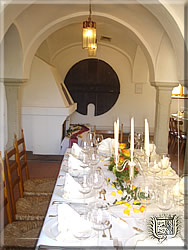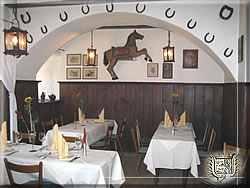| Our Restaurant | |
|
Star Cuisine?
|
|
|
The
long-standing culture of eating and drinking of the renaissance at
Eggersberg:
" … He prepared Platina's turnip gratin, scrambled eggs with marjoram, sage, parsley and grated cheese and sent the brothers into rapture with a meat loaf with sausage meat from veal, ginger, cinnamon, saffron and bacon bits. And because of the lack of ingredients he contented himself with delighting in thought in such delicious meals as game stew with red wine, blue grapes, game's blood, cinnamon and ground cloves. Platina and Martino were followed by the Michelangelo of the chefs: Bernardo Scappi. The writings of the Pope's personal chef read like a report from distant worlds. To him everything seemed to be worth making a mental note of and once in a while he moved the quill over the paper to write down the most important details to preserve them for eternity. ..."
Translated excerpt from the book "Trimalchios Fest"
|
|
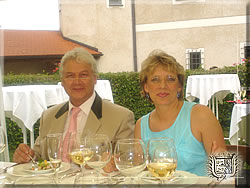
|
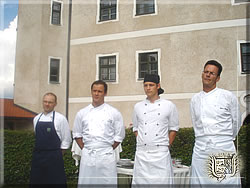
|
|
|
The hosts
of:the "Renaissance Banquet 2006":
H.-P. M. Tassilo and Marion J. Wenzl-Sylvester |
||
|
|
The chefs of the Renaissance Banquet 2006
|
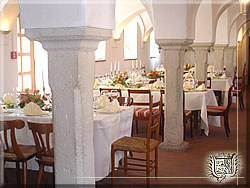 Change
in Cuisine
Change
in Cuisine
The Renaissance cuisine brought a fundamental alteration in the ways food was prepared, not least because of the change in quality. In the Middle Ages cows and chickens had been slaughtered only once they would not give milk and lay eggs anymore. Consequently the meat had been rather stringy when served. However, in the Renaissance period oxen and other animals were kept especially for meat production. Obviously, the quality of the meat became much better. Moreover, the methods of cultivating the land were improved and optimized and fruit refinement emerged and spread quickly. 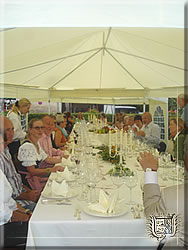 Gardeners,
farmers and even noble ladies, who had a garden set out behind the
house, assisted the chefs by growing savoy cabbage, Swiss chard,
parsnips and radishes. Besides the common herbs and vegetables, new
species like onions, beans and asparagus were grown. Furthermore, by
applying fruit refinement many new strains of apples, pears, cherries,
plums and nuts were cultivated that added to the variety in cooking.
Gardeners,
farmers and even noble ladies, who had a garden set out behind the
house, assisted the chefs by growing savoy cabbage, Swiss chard,
parsnips and radishes. Besides the common herbs and vegetables, new
species like onions, beans and asparagus were grown. Furthermore, by
applying fruit refinement many new strains of apples, pears, cherries,
plums and nuts were cultivated that added to the variety in cooking.
The scholars of the Renaissance rediscovered their interest in the Ancient World. Not only political discourses and treatises were being translated but also cookbooks of the Romans and Greeks. Diligent monks translated them into Latin. Especially the collection of recipes by the epicure Apicius celebrated new triumphs in the Renaissance. |
|
Italy as
pioneer
In the field of cooking, Italy was a pioneer of a new era as well. Because of the favourable situation regarding maritime trade, the Italian chefs had ingredients at their disposal which were unaffordable in other countries as a result of customs and trade. 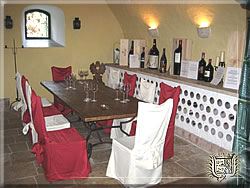 This
applies, for example, for sugar. Sugar and almonds were available at a
much better price in Venice than in other cities. So it is no surprise
that the marzipan began its triumphant success at this place. Figures,
sculptures, cakes and pastries were made out of marzipan and were a
treat for the eyes and the taste buds.
This
applies, for example, for sugar. Sugar and almonds were available at a
much better price in Venice than in other cities. So it is no surprise
that the marzipan began its triumphant success at this place. Figures,
sculptures, cakes and pastries were made out of marzipan and were a
treat for the eyes and the taste buds. Moreover, as a consequence of the active maritime trading the Italians came into contact with "heathens". Old prejudices did not get in the way of the tradesmen; business was more important. Anise, dates, pomegranates, bitter oranges and other delicious ingredients found their way into Italian cuisine. With the work of Platina and Bartolomeo Scappi, Italy could gain a reputation for having the best cuisine in Europe. They called on the chefs of the time to refrain from rich medieval cooking and to turn to "soft" cooking instead. The Wittelsbach family maintained close contact to Italy by means of their salt roads. That way the new ingredients and methods of cooking also found their way to Bavaria and into the kitchen at Eggersberg! |
|
Renaissance cookery books
Many cookery books from the 15th century are still preserved, among others: |
|
|
|
The "Mondseer Kochbuch" fom the Benedictine Monastery of Biburg (mid 15th century) |
|
|
The cookery book of the Dorothee Cloister in Vienna |
|
|
The "Niederdeutsche Kochbuch" (about 1500) |
|
|
A collection of recipes in Latin that were translated by Jamonius de Cremona from Arabic |
|
|
The first German cookery book that was printed, the "Küchenmeisterei", was from Nuremberg (about 1485) |
|
|
The Catalan "libre de Coch" by Maestre Rupert dates back to 1477 |
|
|
The first printed cookery book "This is the Boke of Cokery" dates back to around 1500 |
|
|
The first Dutch cookery book "Notabel Boecken van Cokeryen" dates back to 1510 |
|
|
The first Swiss cookery book and the first book about sweets (Venice) date back to 1541 |
|
|
The book "Banchetti Compositioni di Vivande" by Christoforo di Messisbugo dates back to 1548 |
|
|
Nostradamus' brilliant cookery book about desserts and sweets dates back to 1541 |
|
|
The first printed Belgian cookery book "Eenen Nieuwen Cook Boek" dates back to 1560 |
|
|
Max Rumpolt, chef of the Elector of Mainz, wrote "Ein new Kochbuch" in 1587 |
|
|
Highlights are the works of Platina (around 1474), "De honesta Volupta" |
|
The Eggersberg Wine Guide [PDF, 135 kB, German] |
